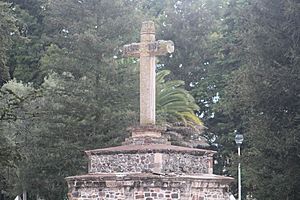Valerio de la Cruz facts for kids
Juan Bautista Valerio de la Cruz (born June 24, 1517 – died 1589) was an important leader from Mexico's native people. He helped the Spanish conquer new lands from groups like the Chichimeca. Later, he became the governor of a region called Jilotepec in what was then known as New Spain. New Spain was the name for the lands in North and Central America that Spain controlled.
Contents
Early Life of Juan Bautista
Juan Bautista Valerio de la Cruz was born with the name Xicalchalchílmitl in a city called Texcoco. He was a descendant of a famous Texcocan poet-king, or tlatoani, named Nezahualcóyotl. After the Spanish took control of Mexico, Xicalchalchílmitl was baptized by a city official from Mexico City. He was given the name "Juan Bautista" because he was born on June 24, which is the feast day of John the Baptist. He got the name "Valerio" from his uncle. The last part, "de la Cruz," was added because he arrived in Jilotepec on May 3, which is the Day of the Cross.
When Juan Bautista was just 10 years old, in 1527, he joined the royal army. By 1529, he had already been promoted to a lieutenant. This meant he was a leader in the royal guard, carrying a lance and shield. After serving for two more years, de la Cruz left the army to work on his land in Texcoco.
Leading Soldiers and Conquering Lands
Juan Bautista returned to serve the Spanish in 1534. He was sent to a frontier city called Jilotepec. He led 80 Spanish soldiers who used a type of gun called an arquebus. He also led 400 native archers. His main job was to protect the road to Zacatecas. This road was very important because Zacatecas was a major source of Mexican silver. He also had to stop attacks from the Chichimeca people in the area. And he worked to keep peace with the local native groups.
Don Antonio de Mendoza, who was the first viceroy (a powerful ruler representing the king) of New Spain, told de la Cruz to gather an army. He was to conquer lands where Chichameca tribes lived. Along with other local caciques (native chiefs), like Fernando de Tapia and Nicolás de San Luis, he helped conquer a large area. This included places around Jilotepec, Tula, San Miguel el Grande, Querétaro, and Michoacán.
Juan Bautista worked to reduce the number of small native settlements. He also helped to teach the local Chichameca people about Christianity and convert them. This was a key part of the Spanish plan to conquer and control the land. By moving nomadic native people into towns, the Spanish could reduce potential fighters. It also made it easier to convert them and gather wealth from the land. The Jilotepec Codex, an old document, also shows that de la Cruz worked closely with Franciscan priests to help with conversions.
Juan Bautista Valerio de la Cruz was very successful in his work. Around 1540, he was chosen to be the governor of the province. By 1545, Viceroy Mendoza gave him the important title of Captain of the Great Chichameca. In 1550, he was named a cacique and lord of Jilotepec. In 1559, Luís de Velasco, the second Viceroy of New Spain, named him Captain-General of the Chichamecas. He took over from Nicolás de San Luis Montañés to lead the local Otomi people against the Chichamecas. Juan Bautista was even given a special coat of arms by Holy Roman Emperor Carlos V. And King Felipe II of Spain allowed him to wear the cross and uniform of the Order of Santiago, a famous military and religious order.
Helping the Community
During his time in the Jilotepec region, Juan Bautista did many good deeds for the community. In 1565, thanks to his efforts, the building of an open chapel in Jilotepec began. This chapel, called Nuestra Señora de la Limpia Concepción, was mainly for the local native people. It was very large, measuring 47 by 27 meters, making it one of the biggest open chapels of its time.
He is also given credit for building the first churches in several towns. These include La Parroquia de San Pedro y San Pablo in Jilotepec, La Catedral de San José in Tula, and Parroquia de San Mateo Apóstol in Huichapan. He also built the Cruz del Doendó and rebuilt Jilotepec's Atrial Cross. These are two famous stone crosses in Jilotepec.
In 1569, he started building several bridges in the region, especially in Jilotepec and Tula. These bridges made it easier to travel on the Camino Real, an important royal road.
Later Years and Death
Don Juan Bautista Valerio de la Cruz passed away in Jilotepec in 1589. He was buried with great honor and ceremony. The Viceroy ordered that he be buried in the Convent of Santiago in Tlatelolco, Mexico.
See also
 In Spanish: Valerio de la Cruz para niños
In Spanish: Valerio de la Cruz para niños




